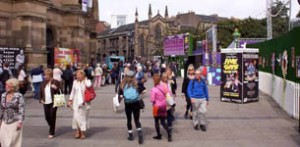 Scotland on Sunday recently ran a story announcing that JD Wetherspoon has expansion plans which could spread it’s bar and restaurant brand further across Scotland, as far north as Orkney.
Scotland on Sunday recently ran a story announcing that JD Wetherspoon has expansion plans which could spread it’s bar and restaurant brand further across Scotland, as far north as Orkney.
Wetherspoon’s has a turnover approaching £1bn and is second in line to McDonald’s and Starbucks in UK breakfast and coffee sales. It has grown its market share on the back of heavily discounted menus. Presumably this has been possible through an acquisitive strategy, economies of scale, product standardisation and low margins at point of sale and in the supply chain.
In the same issue of Scotland on Sunday – on the same page – Executive Editor Bill Jamieson rightly bemoans the persistently low rate of business start ups in Scotland. The figure is down 8% in the second quarter compared with a year ago, according to the Committee of Scottish Clearing Bankers.
Could these two stories be the opposite sides of the same coin?
I’m just back from a trip to Orkney. It has some of the best preserved prehistoric sites in Europe and Historic Scotland has done an excellent job presenting those it has fully excavated. The best example is Skara Brae: almost a neolithic Brookside (although no human remains were found under what is perhaps the earliest known stone patio).
Skara Brae, is a small community of identical houses, all directly connected by partly covered passageways. It was built 5000 years ago and is older than the Giza Pyramid and Stonehenge. The site sits above a stunning beach where flat stone slabs were split from rocky sheets and dragged up the dunes for use in walls and ceilings. Archaeologists have pieced together how the inhabitants might have lived. This is made easier by the fact that they relied almost entirely upon the resources available locally. It’s a microcosm of vernacular in its true essence.
Even now, Orkney makes good use of its resources, with an excellent range of locally produced food and drink available through shops, bars and restaurants, many of them independently owned. The use of local stone in new buildings has predictably diminished and most modern buildings are drawn from the unimaginative pages of the kit manufacturer’s brochure. Equally, the narrow streets and alleys which respond so well to the micro-climate at Orkney’s main towns of Kirkwall, Stromness and St Margaret’s Hope are not replicated in the suburban edge developments of recent times. Nothing new there.
Heading back through Edinburgh Airport, I found myself strolling past the Sir Walter Scott restaurant. This is one of Wetherspoon’s typically engorged establishments, themed in some intangible inbred style sired by largely-mythical Georgian, Victorian and Edwardian ancestors. A pub chain established in 1979, occupying space in a 21st Century airport terminal, presenting a hybrid 18th-20th Century facade. If our world really is fashioned in our own image then it’s time we paused to reflect upon ourselves.
The last thing Orkney needs is JD Wetherspoon’s. This voracious new arrival would squeeze the life out of local businesses, dumbing down the unique identity of the place by creating a grotesque Stone Age-themed cavern. That said, some of the local pubs and restaurants might want to raise their game as a means of defending their territory. Understanding the enemy might be a good place to start.
Richard Heggie

